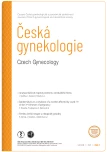Tissue expression analysis of cervical mucus proteome
Authors:
J. Vodička 1
; J. Dostál 1
; D. Holub 2
; Radovan Pilka 1
; P. Džubák 2
; M. Hajdúch 2
; T. Oždian 2
Authors place of work:
Porodnicko-gynekologická klinika LF UP a FN Olomouc
1; Ústav molekulární a translační medicíny, LF UP v Olomouci
2
Published in the journal:
Ceska Gynekol 2023; 88(1): 4-12
Category:
Původní práce
doi:
https://doi.org/10.48095/cccg20234
Summary
Cervical mucus is a viscous fluid functioning as a cervix plug. Products of the endometrial and cervical glands can be detected in the cervical mucus. Cervical mucus is further enriched with transudate originating from the fallopian tubes and proteins originating from the ovaries, peritoneum and distant tissues. With increasing levels of ovarian estrogens, the properties of cervical mucus for possible collection and processing change appropriately. For these reasons, we chose a group of 10 patients treated in the center of assisted reproduction by controlled ovarian stimulation for in vitro fertilization. This study focuses on the proteomic characterization of cervical mucus and localizes the possible sources of the identified proteins. The most abundant proteins were extracellular proteins, mainly mucins; however, most of the identified proteins, present usually in lower quantities, were of intracellular origin. The tissue analysis revealed that proteins from female reproductive organs are also expressed in other tissues in addition to female reproductive organs, but also proteins specific to the testis, liver, placenta, retina, and cerebellum. This study confirms the suitability and high potential of cervical mucus as a source of proteomic biomarkers not only for the diagnosis of the female reproductive tract.
Keywords:
proteomics – cervical mucus – tissue expression
Zdroje
1. Crha K, Ventruba P, Žáková J et al. Cervical mucus and its role in reproduction. Ceska Gynekol 2020; 85 (5): 333–338.
2. Insler V, Melmed H, Eichenbrenner I et al. The cervical score: a simple, semi-quantitative method for monitoring of the menstrual cycle. Int J Gynecol Obstet 1972; 10 (6): 223–228. doi: 10.1002/j.1879-3479.1972.tb00857.x.
3. Kunz G, Leyendecker G. Uterine peristaltic activity during the menstrual cycle: characterization, regulation, function and dysfunction. Reprod Biomed Online 2002; 4 (Suppl 3): 5–9. doi: 10.1016/s1472-6483 (12) 60108-4.
4. Oždian T, Vodička J, Dostál J et al. Proteome mapping of cervical mucus and its potential as a source of biomarkers in female tract disorders. Int J Mol Sci 2023; 24 (2): 1038. doi: 10.3390/ijms24021038.
5. Wiśniewski JR. Quantitative evaluation of Filter Aided Sample Preparation (FASP) and multienzyme digestion FASP protocols. Anal Chem 2016; 88 (10): 5438–5443. doi: 10.1021/acs.analchem.6b00859.
6. Rappsilber J, Ishihama Y, Mann M. Stop and go extraction tips for matrix-assisted laser desorption/ionization, nanoelectrospray, and LC/MS sample pretreatment in proteomics. Anal Chem 2003; 75 (3): 663–670. doi: 10.1021/ac026 117i.
7. Thul PJ, Åkesson L, Wiking M et al. A subcellular map of the human proteome. Science 2017; 356 (6340): eaal3321. doi: 10.1126/science.aal3321.
8. Brazdova A, Senechal H, Peltre G et al. Immune aspects of female infertility. Int J Fertil Steril 2016; 10 (1): 1–10. doi: 10.22074/ijfs.2016. 4762.
9. Schjenken JE, Robertson SA. The female response to seminal fluid. Physiol Rev 2020; 100 (3): 1077–1117. doi: 10.1152/physrev.00013. 2018.
10. Robertson SA, Sharkey DJ. Seminal fluid and fertility in women. Fertil Steril 2016; 106 (3): 511–519. doi: 10.1016/j.fertnstert.2016.07. 1101.
11. Schreiber G. The synthesis and secretion of plasma proteins in the liver. Pathology (Phila.) 1978; 10 (4): 394. doi: 10.1016/S0031-3025 (16) 39817-8.
12. Adnane M, Meade KG, O’Farrelly C. Cervico-vaginal mucus (CVM) – an accessible source of immunologically informative biomolecules. Vet Res Commun 2018; 42 (4): 255–263. doi: 0.1007/s11259-018-9734-0.
13. Pockley AG, Barratt CL, Bolton AE. Placental protein 14 (PP14) content and immunosuppressive activity of human cervical mucus. Symp Soc Exp Biol 1989; 43: 317–323.
14. He B, Xu J, Tian Y et al. Gene coexpression network and module analysis across 52 human tissues. Biomed Res Int 2020; 2020: 6782046. doi: 10.1155/2020/6782046.
15. Kosmas IP, Malvasi A, Vergara D et al. Adrenergic and cholinergic uterine innervation and the impact on reproduction in aged women. Curr Pharm Des 2020; 26 (3): 358–362. doi: 10.2174/1381612826666200128092256.
16. Tommaso SD, Cavallotti C, Malvasi A et al. A qualitative and quantitative study of the innervation of the human non pregnant uterus. Curr Protein Pept Sci 2017; 18 (2): 140–148. doi: 10.2174/1389203717666160330105 341.
Štítky
Dětská gynekologie Gynekologie a porodnictví Reprodukční medicínaČlánek vyšel v časopise
Česká gynekologie

2023 Číslo 1
Nejčtenější v tomto čísle
- Kryokonzervace ovariální tkáně jako metoda pro zachování fertility u žen
- Předčasný odtok plodové vody před termínem porodu
- Fertilitu šetřící terapie u ektopické gravidity
- Staré a nové pohľady na funkčnú morfológiu vajíčkovodov a ich význam pre gynekologickú prax
